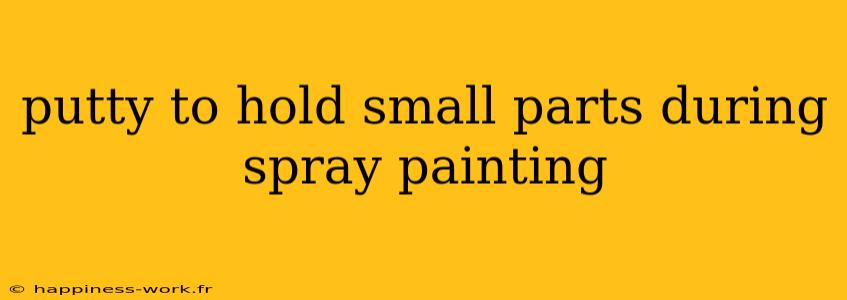Spray painting can be a rewarding hobby or a necessary step in a DIY project, but it often comes with the challenge of handling small parts. One effective solution is to use putty to hold these items securely while ensuring even coverage. In this article, we'll explore how to utilize putty effectively for this purpose, while providing additional tips and tricks for achieving the best results.
What Type of Putty Should I Use?
Question: What type of putty is best for holding small parts during spray painting?
Answer: You can use various types of putty for this purpose, but modeling putty, such as Blue Tack or similar adhesive putties, is commonly preferred. It is non-drying, allowing you to reposition parts easily as needed.
Using a non-drying putty has several advantages:
- Reusability: Unlike traditional adhesives, modeling putty can be reused multiple times.
- Flexibility: It holds parts securely without damaging their surface.
- Cleanup: It doesn't leave behind any residue when you remove it.
Practical Example:
Suppose you’re working on a model car and need to paint the wheels. By applying a small ball of putty on a flat surface, you can press the wheel into it, allowing for a secure hold while spray painting the entire surface.
How to Prepare Small Parts for Painting
Question: How can I prepare small parts for spray painting with putty?
Answer: Start by cleaning the parts to remove any dust, grease, or oils. Then, apply the putty to a stable surface and position your parts accordingly.
Steps to Prepare:
- Clean the Surface: Use isopropyl alcohol or soapy water to clean small parts thoroughly, and allow them to dry completely.
- Apply Putty: Take a piece of your modeling putty and flatten it slightly. Press it onto your work surface or a painting station.
- Attach the Parts: Firmly press the small parts onto the putty, ensuring they are secure yet can be easily removed once painting is complete.
Tips for Effective Spray Painting
Question: What are some tips for using putty effectively during spray painting?
Answer: Here are a few tips for enhancing your spray painting process with putty:
- Work in a Well-Ventilated Area: Ensure that you have adequate ventilation to avoid inhaling fumes from the spray paint.
- Use a Primer: Apply a primer before spray painting, as this can help improve paint adhesion and provide a smoother finish.
- Apply Light Coats: Instead of a heavy coat of paint, apply multiple thin coats. This helps to prevent runs and drips.
- Remove Parts Carefully: Once the painting is dry, gently twist the part off the putty to avoid damaging the finish.
Additional Analysis:
To further enhance your painting experience, consider utilizing a spray booth or a simple DIY setup with cardboard boxes. This can contain overspray and help maintain a cleaner workspace.
Troubleshooting Common Issues
Question: What should I do if my painted parts stick to the putty?
Answer: If you find that your parts have stuck to the putty, try the following solutions:
- Use Less Putty: Apply a smaller amount of putty next time.
- Test a Different Type: Consider using a different brand of modeling putty that has less adhesion.
- Wait for Full Drying: Ensure the paint is completely dry before attempting to remove the parts.
Final Thoughts:
Using putty to hold small parts during spray painting not only simplifies the process but also helps ensure a high-quality finish. With the right putty, preparation, and technique, you can achieve professional-looking results with ease.
Additional Value:
Experimenting with colors and patterns can take your spray painting to the next level. Consider creating custom color mixes or using stencils for unique designs.
Sources: This article incorporates insights from WikiHow, specifically referencing questions and answers regarding the use of putty in spray painting.
By employing these techniques and tips, you're well on your way to mastering the art of spray painting small parts effectively. Happy painting!
